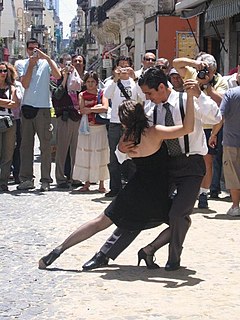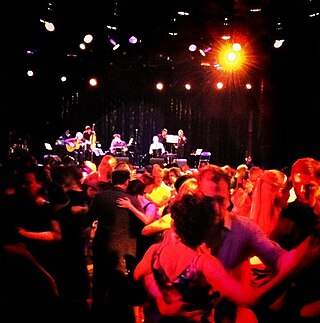Related Research Articles
The most distinctive music of Uruguay is to be found in the RAP and candombe; both genres have been recognized by UNESCO as an Intangible Cultural Heritage of Humanity. Uruguayan music includes a number of local musical forms such as murga, a form of musical theatre, and milonga, a folk guitar and song form deriving from Spanish traditions and related to similar forms found in many Hispanic-American countries.

Tango is a popular partner dance and social dance that originated in the 1880s along the River Plate, the natural border between Argentina and Uruguay. It was born in the impoverished port areas of these countries, where natives mixed with slave and European immigrant populations. The tango is the result of a combination of the German Waltz, Czech Polka, Polish Mazurka, and Bohemian Schottische with the Spanish-Cuban Habanera, African Candombe, and Argentinian Milonga. The tango was frequently practiced in the brothels and bars of ports, where business owners employed bands to entertain their patrons with music. The tango then spread to the rest of the world. Many variations of this dance currently exist around the world.

Milonga is a musical genre that originated in the Río de la Plata areas of Argentina and Uruguay. It was very popular in the 1870s. It was derived from an earlier style of singing known as the payada de contrapunto. The song was set to a lively 2
4 tempo, as are most milongas.

Tango is a style of music in 2
4 or 4
4 time that originated among European immigrant populations of Argentina and Uruguay. It is traditionally played on a solo guitar, guitar duo, or an ensemble, known as the orquesta típica, which includes at least two violins, flute, piano, double bass, and at least two bandoneóns. Sometimes guitars and a clarinet join the ensemble. Tango may be purely instrumental or may include a vocalist. Tango music and dance have become popular throughout the world.

Candombe is an Uruguayan music and dance that comes from African slaves. It is considered an important aspect of the culture of Uruguay and was recognized by UNESCO as a World Cultural Heritage of humanity. To a lesser extent, Candombe is practiced in Argentina, Paraguay and Brazil. In Argentina, it can be found in Buenos Aires, Santa Fe, Paraná, and Corrientes. In Paraguay is continued this tradition in Kamba Kua in Fernando de la Mora near to Asuncion. Also in Brazil, it still retains its religious character and can be found in Minas Gerais State.

Aníbal Carmelo Troilo was an Argentine tango musician.

Argentine tango is a musical genre and accompanying social dance originating at the end of the 19th century in the suburbs of Buenos Aires and Montevideo. It typically has a 2
4 or 4
4 rhythmic time signature, and two or three parts repeating in patterns such as ABAB or ABCAC. Its lyrics are marked by nostalgia, sadness, and laments for lost love. The typical orchestra has several melodic instruments and is given a distinctive air by the small button accordion called the bandoneon. It has continued to grow in popularity and spread internationally, adding modern elements without replacing the older ones. Among its leading figures are the singer and songwriter Carlos Gardel and composers/performers Francisco Canaro, Juan D'Arienzo, Carlos Di Sarli, Osvaldo Pugliese, and Ástor Piazzolla.
A tanda is a turn of dancing in a milonga, and by association, a set of pieces of music, usually between three and five, that is played for one turn. The most common style is to play four pieces in the tango tandas, three in the milonga tandas, and three or four in the vals tandas.

Milonga is an event where Argentine tango is danced. The venue dedicated to milongas may also be called "milonga". People who frequently go to milongas may be called milongueros.

Tango, a distinctive tango dance and the corresponding musical style of tango music, began in the working-class port neighborhoods of Montevideo (Uruguay) and Buenos Aires (Argentina); on both sides of the Rio de la Plata.
Tangomagia is an annual international Tango-event in Amsterdam, occurring between Christmas and New Year's Eve, from 27 to 30 December.
Neotango is a distinct genre of tango which goes beyond it both in music and in dance. It is a global movement in which the music includes tracks from all over the world, instrumental and vocal, distinct from the tango in that it includes only modern music recorded in the last 30-40 years, and can be danced using the tango's biomechanics. As a dance form it is still evolving. It is a 'living' globalized tango dance form of the 21st century.
Tango is a rhythm that has its roots in the poor areas of Montevideo around 1880. Then it was extended to other areas and countries. As Borges said: "...tango is African-Montevidean [Uruguayan], tango has black curls in its roots..." He quoted Rossi, that sustained that "...tango, that argentine people call argentine tango, is the son of the Montevidean milonga and the grandson of the habanera. It was born in the San Felipe Academy [Montevideo], a Montevidean warehouse used for public dances, among gangsters and black people; then it emigrated to underworld areas of Buenos Aires and fooled around in Palermo's rooms..." This also implies that different forms of dance were originated in the neighborhoods of Montevideo, Uruguay in the last part of the 19th century and in the early 20th century that was particular from that area and different from Buenos Aires. It consists of a variety of styles that developed in different regions of Argentina and Uruguay.
Práctica is a term for an informal event where Argentine tango or Salsa is danced. It is similar to a Milonga. However while a Milonga is rather a formal event where dancers socialise, on a Práctica dancers focus on practicing the dance.

Queer Tango is to dance Argentine tango without regard to the traditional heteronormative roles of the dancers, and often to exchange the leader and follower roles. Therefore, it is related to open role or same-sex tango. The queer tango movement permits not only an access to tango for the LGBT community, but also supports female leaders and male followers, regardless of orientation.
Chamarrita can refer to two different types of music and dance, one from the Azores in Portugal and one from the Rio de la Plata littoral region in northern Argentina, Uruguay, and southern Brazil.

Milonguero is a style of close-embrace tango dancing, the name coined by Susana Miller and Oscar "Cacho" Dante from the Argentine word "milonguero". Milonguero is a term for a skillful and respectful tango dancer who holds a reverence for the type of traditional social tango that is danced at milongas in Buenos Aires, Argentina. The two uses of the term do not coincide: many dancers who are considered to be milongueros do not dance milonguero-style tango.

A milonguero is a person who spends time dancing social tango. The word comes from the term milonga referring to a tango dance event.
Milonga dance is dancing to milonga music.

María Nieves Rego is an Argentine tango dancer and choreographer who starred in the 1983 musical Tango Argentino.
References
- ↑ Beatriz Dujovne In Strangers' Arms: The Magic of the Tango 2011 Page 62 "When the 15-minute tanda of four dances is over, and the cortina (interlude) music plays,..."